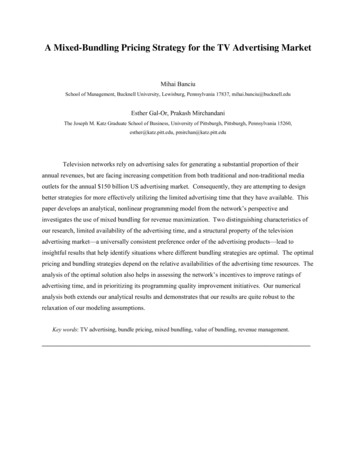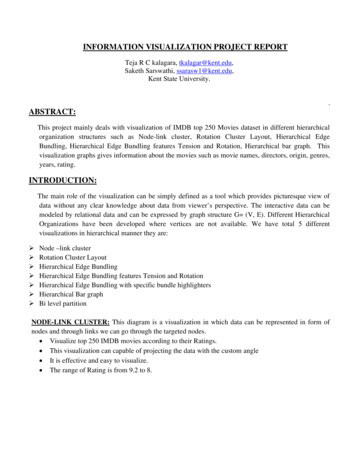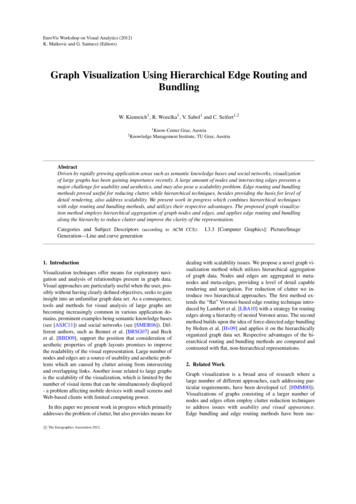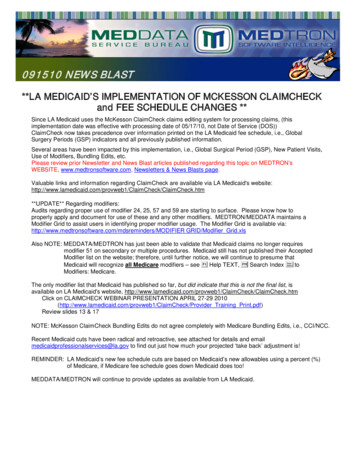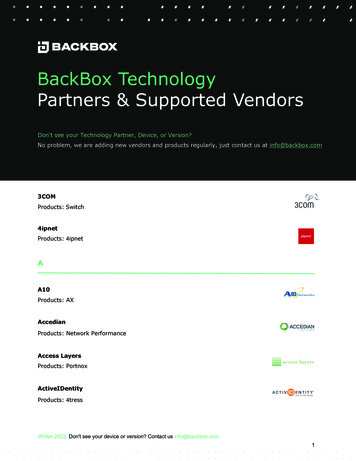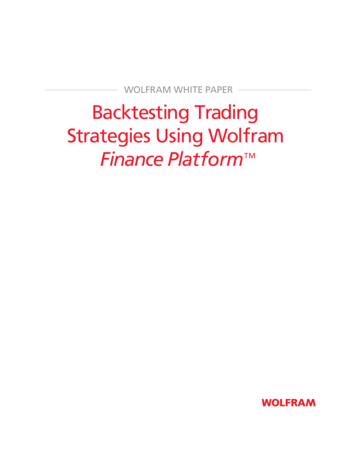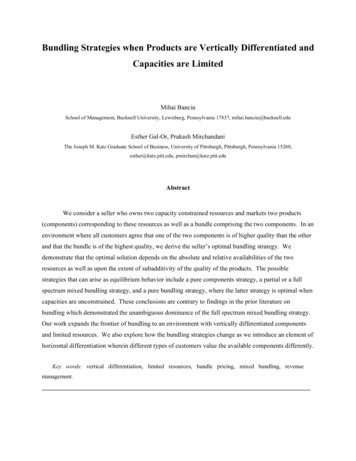
Transcription
Bundling Strategies when Products are Vertically Differentiated andCapacities are LimitedMihai BanciuSchool of Management, Bucknell University, Lewisburg, Pennsylvania 17837, mihai.banciu@bucknell.eduEsther Gal-Or, Prakash MirchandaniThe Joseph M. Katz Graduate School of Business, University of Pittsburgh, Pittsburgh, Pennsylvania 15260,esther@katz.pitt.edu, pmirchan@katz.pitt.eduAbstractWe consider a seller who owns two capacity constrained resources and markets two products(components) corresponding to these resources as well as a bundle comprising the two components. In anenvironment where all customers agree that one of the two components is of higher quality than the otherand that the bundle is of the highest quality, we derive the seller’s optimal bundling strategy. Wedemonstrate that the optimal solution depends on the absolute and relative availabilities of the tworesources as well as upon the extent of subadditivity of the quality of the products. The possiblestrategies that can arise as equilibrium behavior include a pure components strategy, a partial or a fullspectrum mixed bundling strategy, and a pure bundling strategy, where the latter strategy is optimal whencapacities are unconstrained. These conclusions are contrary to findings in the prior literature onbundling which demonstrated the unambiguous dominance of the full spectrum mixed bundling strategy.Our work expands the frontier of bundling to an environment with vertically differentiated componentsand limited resources. We also explore how the bundling strategies change as we introduce an element ofhorizontal differentiation wherein different types of customers value the available components differently.Key words: vertical differentiation, limited resources, bundle pricing, mixed bundling, revenuemanagement.
1. IntroductionSimon Property Group (SPG),1 the largest shopping-mall owner in the US, leases mall space toretailers. Its portfolio of properties includes premium malls such as the Copley Place in the exclusiveBackBay area of Boston, MA as well as normal malls in the same market such as the Arsenal Mall just afew miles away. Premium malls are situated in more attractive and more accessible locations; they alsoattract shoppers with higher disposable incomes compared to normal malls. As a consequence, mallretailers consider premium-mall space to be more valuable than normal-mall space. However, a retailer’sability to generate higher revenues at premium malls varies greatly depending on the products it sells. Forinstance, Johnston and Murphy (J&M), and Aldo both sell men’s shoes and accessories at both types ofmalls. However, J&M, appealing to the well-heeled professional, derives greater value from a premiummall store than does Aldo. Similarly, premium-mall locations generate greater value for Tiffany and Co.and Williams-Sonoma as compared to Zales Jewelers and the Kitchen Collection. Given this variabilityin the retailer valuations, SPG can more successfully extract rents from retailers by designing a productline that facilitates enhanced segmentation of the population of retailers. Specifically, in addition tooffering separate store leases in each mall type (premium or normal), it can also offer at a discountedprice a bundle (Stigler, 1963) consisting of two stores, one from each type of mall.2With bundling as an option, a seller (e.g., the mall owner) can choose between a: (i) pure componentsstrategy, that is, offer the products (components) only as separate items; (ii) pure bundling strategy, thatis, offer only the package of the two components; and (iii) mixed bundling strategy, that is, offer both thebundle and the components. Mixed bundling offers the opportunity to more precisely segment themarket, and previous literature has shown (Schmalensee, 1984) that this strategy (weakly) dominates the1http://www.simon.com/about simon/index.aspxAs evidence of bundling in this sector, consider the February 17, 2010 article about SPG’s bid to acquire GeneralGrowth in which the Wall Street Journal reported “[SPG’s] size would mean that retail chains such as Gap Inc. andAnnTaylor Corp. would have only one landlord to deal with when negotiating leases and opening stores at manyhigh-end malls. A mall owner with hundreds of properties can pressure retailers into opening stores in strugglinglocations as a condition of getting space at its choicest sites.”22
other two strategies. However, in practice, we see marketers using all three strategies. This paperexamines this heterogeneity in the use of bundling by deriving optimal revenue-maximizing strategies forsellers such as SPG, who offer vertically differentiated products in a limited capacity environment.Mall retailers consider a premium mall store to be more attractive than a normal mall store, and abundle of both stores to be more attractive than the premium product by itself. Thus, given suitably lowprices, all buyers prefer the normal product to no product, the premium product to the normal product,and the bundle to the premium product. This vertical differentiation exists in many other markets as well.In television advertising, advertisers consider prime-time to be more valuable than non-prime time since ittraditionally attracts a higher number of viewers. As another example, IDS (of the Li and Fung group)operates pharmaceutical manufacturing plants in both Malaysia and Thailand.3 Companies buymanufacturing capacity from IDS, and value capacity in Malaysia more highly than in Thailand due tobetter overall infrastructure4 and better corporate governance (McGee, 2008). Obviously, in thesesituations, the bundle provides the highest value. The extant bundling literature has not studied this typeof preference ordering, arising due to differing quality ratings, among the products.The resource availability in settings such as shopping mall and contract manufacturing is limited.Likewise, in television advertising published data suggests that competitive pressures implicitly limit thecommercial time networks use: The non-programming minutes per hour are 16:32, 16:36, 16:46, and16:57 for Fox, CBS, NBC, and ABC respectively.5 Based on these observations, we assume that theresource availabilities are limited, and investigate how the seller’s decisions change with capacity. Noneof the previous bundling literature has modeled either vertical differentiation or resource availabilities.The relationship among the quality ratings of the products is another important factor thatdistinguishes our work from previous bundling literature. For example, the number of unique ces/CH1.pdf. World Bank report. ToLearn/tvclutter.pdf. Report by American Association ofAdvertising Agencies and the Association of National Advertisers. 1999.43
visiting Gap at a bundle of premium and normal mall locations in a particular trade area is likely to belower than the sum of unique shoppers at each of the two stores if it were to open one without the other.In other words, the quality ratings have a subadditive relationship in the shopping mall application. Aswe argue later, other situations may have a superadditive quality relationship; we study how the nature ofthis relationship further affects the seller’s optimal bundling strategy.Certain characteristics of our problem (e.g., perishable resources, fixed capacities) suggest anoverlap with the revenue management literature (see the comprehensive book by Talluri and van Ryzin(2004) and the survey by Bitran and Caldentey (2003)). However, our study differs significantly fromtraditional revenue management work in terms of the contextually-specified relationship between thequality ratings of the products, the basis for market segmentation, and the research focus. For example,previous revenue management literature focused primarily on travel related industries (airline, lodging,cruise, or car rental) where horizontal, not vertical, differentiation is prevalent. Even in other industriessuch as television advertising, the revenue management research focus is on optimizing advance sales(Bollapragada and Mallik, 2008) or capacity allocation between advance and spot markets (Araman andPopescu, 2010), rather than on modeling the vertically differentiated market. Furthermore, in thisliterature, customers are segmented a priori according to demographical or observed/forecasted behavioraltraits (e.g. business/leisure travelers), and companies implement “fences” (e.g., a Saturday night stay astudent id requirement) in order to prevent spillage between segments. Our approach, on the other hand,uses a self-selection mechanism for (second degree) price discrimination.Our analysis combines vertically differentiated products and limited resource availability toobtain several novel and insightful results. First, when the quality ratings are subadditive, we show thatas observed in practice, a full range of segmentation strategies can be optimal. This is contrary to pastbundling literature which shows that the mixed bundling strategy (weakly) dominates the purecomponents and the pure bundling strategies. Interestingly, the tightness and the relative tightness of theavailable resources play a pivotal role in determining the optimal strategy. With superadditive qualityratings, the optimal set of strategies still depends on the resource availability but no longer spans full4
market segmentation or pure components. When capacities are unconstrained the optimal strategy isalways pure bundling. Thus, the clean, unambiguous structure of the optimality of mixed bundling breaksdown when the products are vertically differentiated and resources are limited. Second, whereas theearlier literature tied the benefit from mixed bundling primarily to the extent of heterogeneity in consumerpreferences (Schmalensee, 1984) we demonstrate that the skewness of the distribution of preferences isalso important. Third, we underscore how the degree of the subadditivity in the ratings affects the optimalstrategy, showing that increased subadditivity increases the propensity to use the mixed bundling and thepure component strategies—this result is antithetical to our a priori intuition which suggests thatincreased subadditivity would lead to enhanced use of only the pure components strategy. Finally, tomodel the situation where quality ratings depend on the market segment, we develop and analyze a modelwith added horizontal differentiation. We demonstrate that increased horizontal product differentiationhas an effect that is similar to reduced subadditivity of the ratings of the vertically differentiatedcomponents.This paper is organized as follows. Section 2 discusses our modeling assumptions and develops anonlinear pricing model. In Section 3, we analyze the optimal solution properties assuming a uniformdistribution of the buyer’s efficiency. Section 4 studies the impact of horizontal differentiation. Section 5shows that our conclusions are quite robust and hold for other distributions as well. Section 6 concludesthe paper by identifying some future research directions.2. The ModelA monopolist shopping mall owner or a monopolist television broadcasting network,6 both ofwhom we refer to generically as the seller, considers offering for sale her7 available resources, which are6If SPG’s acquisition of General Growth is successful, it would own more than a third of all malls and more thanhalf of all premium malls (The Wall Street Journal, February 17, 2010, Simon Offers 10 Billion for GeneralGrowth). Coupled with high entry barriers in the shopping mall industry, this fact suggests that SPG is a virtualmonopoly at least in some regions. Similarly, some television broadcasting market segments (channels), such assports (ESPN), music (MTV), comedy (CC), and cooking (FOOD), exhibit a virtual monopolistic environment.7Where necessary, we use feminine gender for the seller and masculine gender for the buyer.5
of two types: normal and premium. The availability of both resources is fixed, with qN (qP) denoting theamount of normal (premium) resources available. The seller’s objective is to maximize her total revenue.As in Bakos and Brynjolfsson (1999), we assume that the variable costs of both resources are zero.8 Theseller considers three products: the normal and the premium products consisting of one unit of thecorresponding resources, and a bundle consisting of one unit of each of the two resources. These itemscan be advertising time during nonprime time (normal) and prime time (premium) segments, or retailstores in normal and premium malls.The market consists of buyers interested in purchasing these three products. In line with thebundling literature (Adams and Yellen, 1976; Schmalensee, 1984), we assume that the marginal utility ofa second unit of capacity of a given type is zero for all buyers.9 Buyers have a strict ordering of theirpreferences: They prefer purchasing (i) a bundle to a premium product, (ii) a premium product to anormal product, and (iii) a normal product to refraining from purchasing altogether. We designate thequality ratings of the normal, premium, and the bundle options by α, β, and γ, respectively, where, 0 α β γ.Let (γ β) / denote the quality relationship parameter. We consider both 1 and 1,representing respectively a subadditive and a superadditive relationship in the quality ratings. We say thatratings subadditivity increases (decreases) when decreases (increases). The premium and the normalshopping mall would attract shoppers from the same trade area and so the quality ratings exhibit asubadditive relationship. Similarly, Goettler (1999), and Brown and Cavazos (2003) observe empiricallya subadditive relationship in an advertising setting where multiple showings of a television commercialincrease the number of unique viewers less than proportionally. Jones’ (1997) empirical analysis also8When the components are independently valued and resource availability is unlimited, unit costs have beenconsidered earlier in the literature by McAfee et al. (1989), among others. Their results show that mixed bundling isthe (weakly) dominant strategy, in contrast to the full range of optimal strategies that we obtain. We conjecture thatfor the situation we are modeling, unit component costs do not affect the general thrust of our findings.9Keeping this assumption invariant while introducing vertical differentiation and limited resource capacities allowsus to isolate the effect of these two aspects on the seller’s marketing strategy, and contrast our findings with those inthe existing literature. For a relaxation of this assumption, see Hitt and Chen (2005) and Wu et al. (2008).6
indicates a subadditive relationship between product sales and the number of advertisements. On theother hand, other researchers (McDonald, 1979; Naples, 1979) have argued that repeated exposures to thesame commercial may be necessary for modifying consumption habits. Hence superadditivity may bemore appropriate in this case. As well, quality ratings may reflect a superadditive relationship when thereare multiple decision makers who have different viewing preferences. For example, Mattel mightadvertise during non-prime time to target children and during prime time to target the parent. To sell abig ticket item such as an automobile or a large kitchen appliance, both spouses (who may have differentviewing habits) may need to be targeted, and so a company like Maytag may see advertisements duringprime time and non-prime time as complementing each other. Similarly, lower catastrophic riskassociated with a dual sourcing strategy by IDS’s clients might argue for superadditivity.Buyers differ in their willingness to pay for the three product variants. For example, a retailersuch as Abercrombie and Fitch may be more willing to lease a store in a premium mall than Dress Barn.While both retailers value the larger volume and higher disposable income of potential customers at apremium mall, Abercrombie and Fitch benefits to a greater extent since premium mall customers tendtypically to be more brand conscious. We designate by the parameter t the intrinsic efficiency of a buyerto generate value from his customers, and assume that this efficiency is continuously distributed on theunit interval according to some (differentiable) probability density function f(t) and cumulativedistribution function F(t). The willingness to pay of a buyer with efficiency t for product variant i is thusequal to t ri, where ri is the quality rating of the ith product variant. These variants are the seller’s normal(N), premium (P), and bundle (B) options.Given this distribution of intrinsic efficiency and the willingness to pay function, the seller’soptimal strategy induces the buyers to self-select into at most four segments as described in Figure 1, withthe thresholds T*, T**, and T*** demarcating the different market segments.10 With this strategy, buyers10The willingness to pay function satisfies the “single crossing property” and therefore facilitates segmentation andguarantees the uniqueness, as well as the monotonicity (0 T*** T** T* 1) of the thresholds.7
in the highest range of intrinsic efficiencies (interval [T*, 1]) choose to purchase the bundle. Those in thesecond highest range (interval [T**, T*)) choose the premium product, those in the third highest range(interval [T***, T**)) choose the normal product, and those in the lowest range refrain from purchasingaltogether. An interval of zero length implies that the seller does not find it optimal to offer thecorresponding product. The values of the threshold parameters T*, T**, and T*** are determined toguarantee that the buyer located at a given threshold level is indifferent between the productscorresponding to the two adjacent intervals separated by this threshold parameter.PLEASE INSERT FIGURE 1 ABOUT HERETo set up the model we define the selling prices for the bundle, premium, and normal products bypB, pP and pN, respectively. The seller’s revenue optimization model with mixed bundling, ROMB, is:[ROMB]subject to:max pB [1 F (T *)] pP [ F (T *) F (T **)] p N [ F (T **) F (T ***)] (1)p B , pP , p N 0pB pP pN,1 F(T**) qP, and1 F(T*) F(T**) F(T***) qN.(2)(3)(4)The seller’s revenue from a market segment equals its size multiplied by the price of thecorresponding product; the total revenue, , in (1) is the sum of the revenues from the three marketsegments. Constraint (2), the “price-arbitrage” constraint, prevents arbitrage opportunities for a buyer tocompose a bundle by buying the premium and the normal products separately.11 Constraints (3) and (4)are capacity constraints for the premium and normal resources.Buyers self-select their purchases (or decide against purchasing any product) based on theirwillingness to pay and the product prices. (See Moorthy (1984) for an analysis of self-selection basedmarket segmentation.) We refer to the difference between a buyer’s willingness to pay and the price of11Unless a systematic secondary market exists, an intermediary may not be able to purchase the components and sellthe bundle at a profit. As a result, constraint (2) will not be necessary if secondary markets can be prevented andbuyers cannot “assemble” the bundle from the components on their own.8
the product he purchases as the net benefit that the buyer derives from the purchase. A buyer willpurchase a product only if his net benefit is nonnegative. Moreover, a buyer will be indifferent, say,between buying the premium product and buying a bundle if he extracts the same net benefit from eitherpurchase. The following relationships (5) between the net benefits are invariant boundary conditions,regardless of the efficiency distribution f(t): T* pB T* pP, T** pP T** pN,and T*** pN 0.(5) These conditions imply T* (pB pP)/( ), T** (pP pN)/( ), and T*** pN/ and nonnegativity of the thresholds implies 0 pN pP pB. Moreover, the net benefit for customers in each ofthe three categories is nonnegative.Before we analyze the situations that arise when at least one of the capacity constraints is binding,Proposition 1 considers the case when neither capacity constraint is binding. Let h(t) f(t) / [1 – F(t)] bethe hazard rate function. The Appendix gives the technicalities of this and all subsequent results.Proposition 1. If the premium and normal resource availability is sufficiently high, th(t) is amonotonically increasing function of t on the domain [0, 1], and h(1) 1, the optimal strategy for theseller is pure bundling. The corresponding optimal threshold is the fixed point of the reciprocal of thehazard rate function of the distribution of buyers, that is, T* [1 F(T*)] / f(T*).The following corollary uses Markov’s inequality to establish an upper bound on the optimalrevenue when the resource availability is unconstrained.Corollary 2. An upper bound on the seller’s total revenue is E T , where E T is the expected valueof the efficiency, t. The revenue collected under the pure bundling strategy is [1 F (T *)] / h(T *) .Note that the monotonicity condition on th(t) and the condition h(1) 1 are satisfied by a largenumber of commonly used distributions such as the Beta (with both shape parameters at least 1), and theUniform and Normal truncated between 0 and 1. See the remark following the proof of Proposition 1 fora more complete list. Thus, the result in Proposition 1 is quite general. Second, this result seems tocontradict previous bundling literature (for example, McAfee, McMillan and Whinston, 1989;9
Schmalensee, 1984) which demonstrates that the mixed bundling strategy weakly dominates both the purebundling and pure components strategies. This apparent contradiction can be explained by the fact thatmarkets are vertically differentiated in our context. In contrast, previous research does not assume suchan ordering. Since every buyer finds the bundle to be the most desirable option, the seller offers only thebundle when the available premium and normal resources are unconstrained. As mentioned previously,the unconstrained case is unlikely to arise in the context of our motivating examples. Broadcasters areconstrained by the advertising time resource and mall operators are similarly capacity constrained.In the next section we derive the analytical solution of the constrained optimization problemunder the simplifying assumption that the efficiency parameter of buyers is uniformly distributed. InSection 5, we extend the results numerically using a Beta distribution.3. Revenue Maximizing Strategies when Capacity is BindingClearly, the capacity constraints in the ROMB model play a significant role in determining theseller’s optimal strategy. Particularly, the relative scarcity of the two resources, premium and normal, isthe main driver of the analysis. For the shopping mall and the television advertising settings, thepremium resource availability constraint (3) is more likely to be binding than the normal resourceavailability constraint (4) due to infrastructural and competitive reasons, respectively. This is notnecessarily true for applications such as the IDS one, where the normal resource availability constraintcould be binding if better incentives were provided by the Malaysian authorities for building capacity. Inthis section, we identify the impact of the capacity constraints on the seller’s optimal strategy when thedistribution of the efficiencies is uniform. We find that the following strategies can arise as the optimalsolution of ROMB: the bundle is not offered, that is, the pure components strategy, PC; only the bundle isoffered, that is, the pure bundling strategy, PB; the bundle, as well as each separate product is offered,that is, the full spectrum mixed bundling strategy, MBPN; the bundle and the premium product areoffered, that is, the partial spectrum mixed bundling strategy, MBP; the bundle and the normal product areoffered, that is, the partial spectrum mixed bundling strategy, MBN.In our derivations, we will demonstrate that the optimal strategy critically depends upon the10
relative availability of qP and qN. To capture this, we define the capacity mismatch (i. e, resourcemismatch) parameter (1 2qN) / (1 2qP). (This non-intuitive form of the capacity mismatchparameter will become apparent in the sequel.) When exceeds one, qN is scarce relative to qP and theopposite is true when is less than one. The parameter equals 1 when both capacities are equal. Wewill show, for instance, that the MBN (MBP) strategy is optimal when is sufficiently less (greater) than1. The MBPN strategy is optimal when the relationship among the quality ratings is subadditive and isclose to one, and qN and qP are both sufficiently large. We will also show that the characterization of thesolution when the partial spectrum mixed bundling strategies (MBP or MBN) are optimal is furthercontingent upon the overall availability of the more abundant resource. Specifically, even though thestrategy itself, say MBP, remains the same, the solution characteristics (e.g., the product prices) dependon whether qP is less than or greater than a threshold value. To distinguish between these two cases, wedesignate by MBP and MBP the partial spectrum mixed bundling strategies when qP is greater than andwhen qP is less than the threshold value, respectively. The threshold value depends on the efficiencydistribution and, for example, equals 1/2 for the uniform distribution. We define the subcategories MBN and MBN of MBN in a similar manner depending on qN.Figure 2a depicts the regions corresponding to the various strategies when the relationshipbetween the quality ratings is subadditive, and Figure 2b depicts these regions when superadditivitycharacterizes the ratings relationship. For the uniform distribution, the unconstrained solution that wedescribed in Section 2 arises when qP and qN are both at least a half. In this case, at the optimal solution,the seller never sells more than an aggregate quantity of one, split equally between the premium andnormal product variants. To depict the constrained solution, therefore, in Figure 2, we restrict attentiononly to the case when qP qN 1. The unconstrained solution in the figure is designated by the point,PB, where qP qN 1/2. We will explain in detail the boundaries for the regions in Figure 2.PLEASE INSERT FIGURE 2 ABOUT HEREThe model ROMB specializes to ROMB U for the uniform distribution case.11
p pP[ROMB U] max pB 1 B pB pP p P p N pP subject to: pP p N p N pN (6)pB pP pN,(7)1 (pP pN)/( ) qP, and(8)1 (pB pP)/( ) (pP pN)/( ) pN / qN.(9)Clearly, the optimal strategy with unlimited resource availabilities (that is, when qP and qN 1/2)is pure bundling. When the quality ratings are subadditive, this strategy is implemented with the prices pB /2, pP /2, and pN /2. With superadditive quality ratings, the prices pB /2, pP /2, and pN ( )/2 support pure bundling. These prices imply T* T** T*** 1/2, and the seller’s revenues are /4. Note that both these solutions also guarantee that the arbitrage constraint (7) is satisfied.We now discuss the capacity constrained case in Proposition 3a (for subadditive ratings) and 3b(for superadditive ratings). We define the propensity to use a particular strategy as the area in the spaceof qP and qN values (see Figure 2) for which the strategy is applicable.Proposition 3a. When the relationship in the quality ratings is subadditive (i.e., when 1),(i)The full range of bundling strategies (PB, PC, MBPN, MBN , MBN , MBP , and MBP )can be optimal depending on the available capacities qP and qN (and hence ), and (ii)The propensity to use the PC and the MBPN strategies increases at the expense of the MBN and MBP strategies as the ratings subadditivity parameter decreases.(iii)Higher subadditivity supports the MBPN strategy for greater discrepancy in the capacitylevels.(iv)MBN is the optimal strategy if 0 qP 1/2, and qN 1/2. Similarly, MBP is the optimalstrategy if 0 qN 1/2, and qP 1/2.(v)The pure bundling strategy, PB, is optimal at a single point qP qN 1/2.(vi)Irrespective of the bundling strategy, no more than 1/2 of the total number of customers areserved by the seller.12
Proposition 3b. When the relationship in the quality ratings is superadditive (i.e., when 1),(i)The MBPN and the PC strategies are never optimal. The PB strategy is optimal when 1.(ii)The optimal strategy does not depend on the quality relationship parameter, According to Part (i) of Proposition 3a, all the different bundling strategies can be optimal whenthe quality ratings are subadditive. Indeed, these strategies arise actually in practice. For example, theAmerican Bankers Association uses a full spectrum mixed bundling strategy, allowing advertisers toplace advertisements in its magazines individually, or in a collection of its magazines (for a discount).12For the partial spectrum mixed bundling case, consider the popular video game console, Nintendo Wii.During the 2008 holiday season, many online retailers were not willing to sell the Wii (which was in shortsupply) by itself; they were offering it only as part of a bundle with Wii accessories, or the accessories bythemselves. On the other hand, an established artist might use a pure components strategy by offering forsale only separate paintings (or sculptures). In this case, given the unique nature of these creations (andthus their scarcity), independent sale derives more value than does bundling. Finally, the CarnegieMuseums of Pittsburgh is an umbrella organiza
2 1. Introduction Simon Property Group (SPG),1 the largest shopping-mall owner in the US, leases mall space to retailers. Its portfolio of properties includes premium malls such as the Copley Place in the exclusive BackBay area of Boston, MA as well as normal malls in the same market such as the Arsenal Mall just a few miles away.

